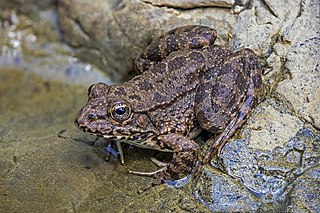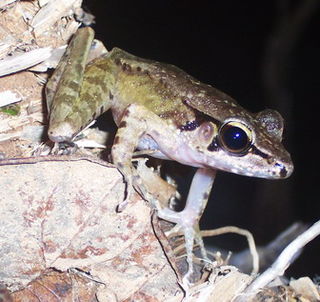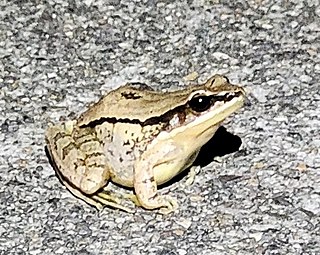
True frogs is the common name for the frog family Ranidae. They have the widest distribution of any frog family. They are abundant throughout most of the world, occurring on all continents except Antarctica. The true frogs are present in North America, northern South America, Europe, Africa, and Asia. The Asian range extends across the East Indies to New Guinea and a single species, the Australian wood frog, has spread into the far north of Australia.

Amolops is a genus of true frogs native mainly to eastern and south-eastern Asia. These frogs are closely related to such genera as Huia, Meristogenys, Odorrana, Pelophylax and Rana, but still form a distinct lineage among the core radiation of true frogs. They are commonly known as "torrent frogs" after their favorite habitat - small rapid-flowing mountain and hill streams - but this name is used for many similar-looking frogs regardless of whether they are loosely related.

Amolops marmoratus is a species of ranid frog found in Asia. Its common names include marbled sucker frog, marbled cascade frog, Pegu torrent frog, and many others. The taxonomic status of many populations formerly assigned to this species is uncertain.

Hose's frog is a true frog species with a wide range in Southeast Asia. This species was named after zoologist Charles Hose.

Torrent frogs are a number of unrelated frogs that prefer to inhabit small rapid-flowing mountain or hill streams with a lot of torrents. They are generally smallish neobatrachians with a greyish-brown and usually darkly mottled back, giving them excellent camouflage among wet rocks overgrown with algae; their well-developed feet make them agile climbers of slippery rocks.
Amolops aniqiaoensis, commonly known as the Aniqiao torrent frog, is a species of frog in the family Ranidae that is endemic to China. It is only known from the vicinity of its type locality, Aniqiao (阿尼桥) in Mêdog County in the southeast of Tibet.

Amolops chunganensis is a species of frog in the family Ranidae. Its type locality, Kuatun village in Wuyishan, Fujian. It is endemic to central, southern and eastern China where it has a wide but scattered distribution ; records from Vietnam probably refer to Amolops mengyangensis.
Amolops medogensis is a species of frog in the family Ranidae, the "true frogs". It is endemic to Mêdog County in southeastern Tibet. Its range might extend into the adjacent Arunachal Pradesh, India. Common name Medog torrent frog has been proposed for it.

Amolops torrentis, commonly known as the torrent sucker frog or the little torrent frog is a species of frog in the family Ranidae and genus Amolops that is endemic to China, specifically only on the island of Hainan. They are most likely to be found in streams and surrounding wetland areas. Males have high-pitched mating calls, which are favored by females. Glands on this species' skin can secrete toxins. This species suffers from parasitism and habitat loss. Currently it is listed as vulnerable by the IUCN and is protected by law in China.

The hole-in-the-head frog is a species of frog in the family Ranidae. It is the only member of the genus Huia. It is found on the island of Borneo. Its natural habitats are subtropical or tropical moist lowland forests, subtropical or tropical moist montane forests, and torrential rivers. It is threatened by habitat loss. The genus name honors Chinese herpetologist Shuchin Hu.

The Javan torrent frog is a species of frog in the family Ranidae. It is endemic to Java, Indonesia. It is found in Mount Halimun Salak National Park, Ujung Kulon National Park, and Gunung Gede Pangrango National Park in West Java, as well as in Dieng Nature Reserve in Central Java.
The Sumatran torrent frog is a species of frog in the family Ranidae. It is endemic to Indonesia. The informally assigned common name for frogs in this genus is torrent frog.
Odorrana chapaensis is a species of frog in the family Ranidae that is found in southern Yunnan in China and in northern Vietnam. It is likely that it also occurs in nearby areas of Laos.
Amolops daorum is a species of frog in the family Ranidae. It is known from its type locality in the vicinity of Sa Pa in northern Vietnam near the Chinese border, Hong Kong, and Houaphanh Province in eastern Laos; presumably it also occurs the intervening areas. The Hong Kong record is considered suspicious, however.
Odorrana exiliversabilis is a species of frogs in the family Ranidae that is endemic to southeastern China where it is found in Fujian, western Zhejiang, and southern Anhui provinces. These frogs can be found in mountain forest streams and are common in suitable habitat. The species is not considered threatened by the IUCN.

Odorrana graminea, the large odorous frog, inhabits fast-flowing streams in elevated mountainous regions of Southern China and Northern Indochina. It is one of 56 species in the genus Odorrana. Male O. graminea are noted for their ultrasonic call characteristics and are one of three frog species able to detect ultrasonic frequencies, likely evolved to facilitate communication amidst noisy streams and waterfalls. Studies on O. graminea courtship vocalizations suggest female preference for increased proportion of nonlinear vocal phenomena (NLP).
Frogs and toads produce a rich variety of sounds, calls, and songs during their courtship and mating rituals. The callers, usually males, make stereotyped sounds in order to advertise their location, their mating readiness and their willingness to defend their territory; listeners respond to the calls by return calling, by approach, and by going silent. These responses have been shown to be important for species recognition, mate assessment, and localization. Beginning with the pioneering experiments of Robert Capranica in the 1930s using playback techniques with normal and synthetic calls, behavioral biologists and neurobiologists have teamed up to use frogs and toads as a model system for understanding the auditory function and evolution. It is now considered an important example of the neural basis of animal behavior, because of the simplicity of the sounds, the relative ease with which neurophysiological recordings can be made from the auditory nerve, and the reliability of localization behavior. Acoustic communication is essential for the frog's survival in both territorial defense and in localization and attraction of mates. Sounds from frogs travel through the air, through water, and through the substrate. Frogs and toads largely ignore sounds that are not conspecific calls or those of predators, with only louder noises startling the animals. Even then, unless major vibration is included, they usually do not take any action unless the source has been visually identified. The neural basis of communication and audition gives insights into the science of sound applied to human communication.

Odorrana, commonly known as odorous frogs, is a genus of true frogs (Ranidae) from East Asia and surrounding regions. Many of these frogs inhabit fast-flowing mountain streams, and they typically have a remarkably pointed snout, as evidenced by common names like tip-nosed frog and scientific names like nasica or nasutus.

Wijayarana is a group of true frogs found in Southeast Asia. Their common name is Wijaya cascade frogs. Many are commonly known as "torrent frogs" after their favorite habitat - small rapid-flowing mountain and hill streams -, but this name is used for many similar-looking frogs regardless of whether they are closely related.










